Discover 11 hidden attractions, cool sights, and unusual things to do in Camden (United States). Don't miss out on these must-see attractions: Poison Springs Battleground State Park, Camden Confederate Monument, and McCollum-Chidester House. Also, be sure to include Oakland Cemetery in your itinerary.
Below, you can find the list of the most amazing places you should visit in Camden (Arkansas).
Table of Contents
Poison Springs Battleground State Park
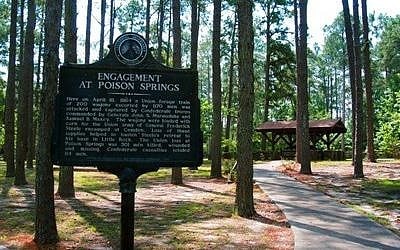
State park in Ouachita County, Arkansas. Poison Springs Battleground State Park is an Arkansas state park located southeast of Bluff City. It commemorates the Battle of Poison Spring in the American Civil War, which was part of the 1864 Camden Expedition, an element of a Union Army initiative to gain control of Shreveport, Louisiana and get a foothold in Texas.
In the battle, which was fought on April 18, 1864, Confederates and Choctaw Indians attacked and overcame a supply wagon of Union soldiers. The term "poison spring" arises from the apocryphal story that Confederate soldiers poisoned nearby springwater. The battle hastened the failure of the Camden expedition, and garnered notoriety for the slaughter of black Union soldiers from Kansas by the Confederate forces, which took no prisoners.
The site was listed on the National Register of Historic Places in 1969 as Poison Springs State Park, and, with other sites, is part of the Camden Expedition Sites National Historic Landmark. It was declared part of the National Historic Landmark in 1994.[1]
Address: Highway 76, Camden
Camden Confederate Monument
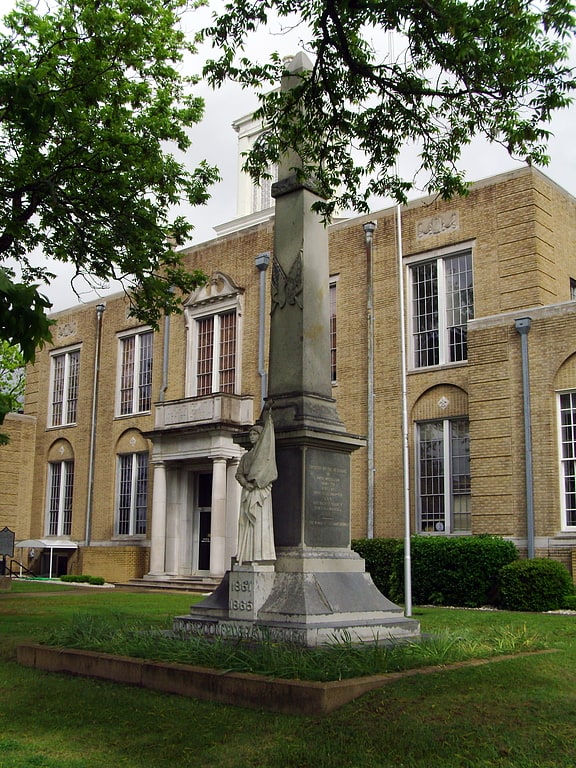
Monument in Camden, Arkansas. The Camden Confederate Monument, also known as the Confederate Women's Memorial, is located on the grounds of the Ouachita County Courthouse in Camden, Arkansas. The sculpture, carved out of Italian marble, depicts a woman dressed in the period of the American Civil War, standing with her feet together, clutching a flagpole. The sculpture is mounted on a block of North Carolina granite, next to a tall obelisk. The statue is 5 feet tall. The obelisk is inscribed on three sides, recognizing the valor of women in the Confederate cause, and the organizations that funded the memorial's construction. The memorial was erected in 1914 by the local chapters of the United Confederate Veterans and the United Daughters of the Confederacy.
The monument was listed on the National Register of Historic Places in 1996.[2]
McCollum-Chidester House
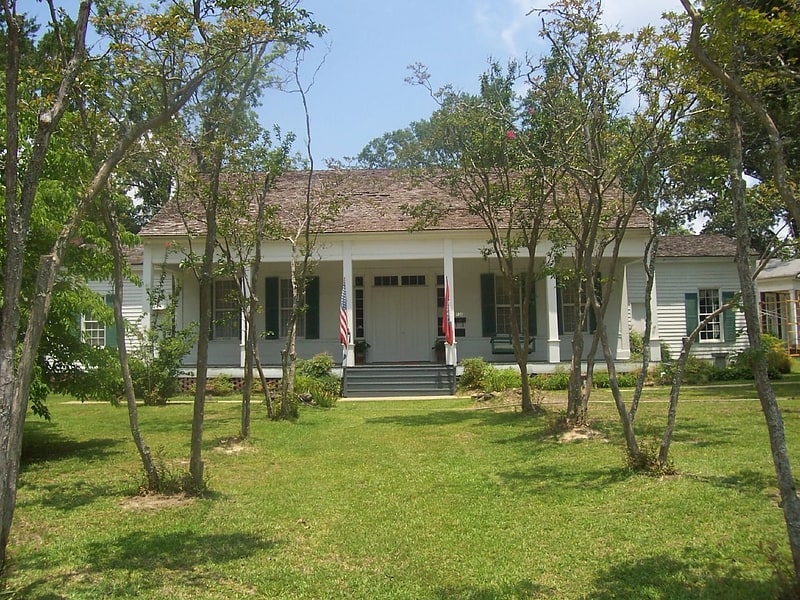
Museum in Camden, Arkansas. The McCollum-Chidester House is a historic house at 926 Washington Street NW in Camden, Arkansas. It is now a museum operated by the Ouachita County Historical Society, along with the Leake-Ingham Building at the rear of the property. The 1+1⁄2-story wood-frame house was built in 1847 by Peter McCollum and sold ten years later to Colonel John T. Chidester. It is one of the finest pre-Civil War Greek Revival mansions in the state. Chidester was a prominent businessman who controversially sought to do business with Union interests during the Civil War. After the war he established a mail company that operated so-called "Star Routes" as far west as the Arizona Territory. He was not implicated in bribery scandals that attended this operation.
The house was listed on the National Register of Historic Places in 1971.[3]
Address: 925 W Washington St, 71701-3381 Camden
Oakland Cemetery

Cemetery in Camden, Arkansas. Oakland Cemetery is a historic cemetery in Camden, Arkansas, located on Maul Road between Pearl Street and Madison Avenue. Established in 1830, it is the city's oldest cemetery. It consists of just over 7 acres of land donated in that year by William L. Bradley, one of Camden's founders. It is the burial site of many of Camden's leading citizens. Among them is James Thomas Elliott, a former Confederate soldier who represented Arkansas's 2nd District as a Republican.
An area of just under one acre which is separated from the rest of the cemetery by a chain fence is reserved for Camden's Confederate States Army fallen, and features a granite obelisk topped by a cannonball. There are 231 graves in this section, including both known and unknown individuals.
The entire cemetery was listed on the National Register of Historic Places in 2000. The Confederate section of the cemetery was separately listed on the National Register in 1996.[4]
St. John's Episcopal Church
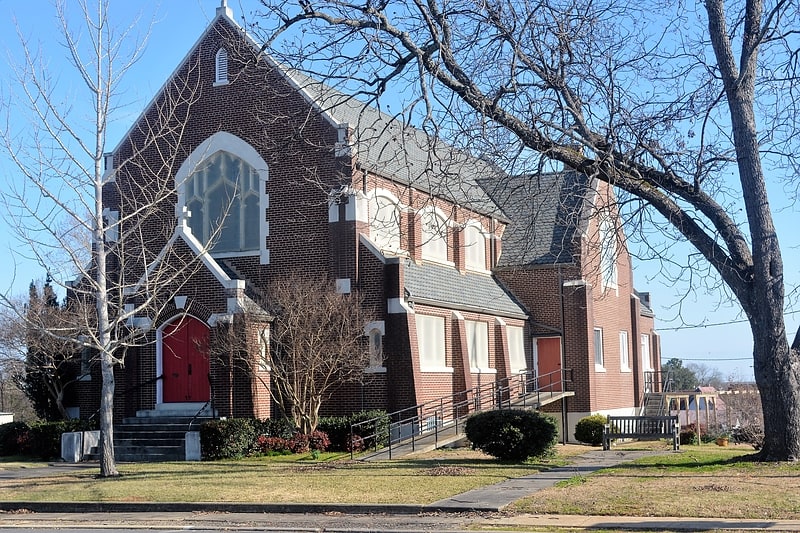
The St. John's Episcopal Church is a historic church at 117 Harrison Street in Camden, Arkansas. It is a large cruciform structure, built out of brick with trim of concrete cast to resemble stone. Its Gothic features include buttresses at the corners and along the sides, and pointed-arch openings for entrances and windows at the gable ends. The church was built in 1925-26 for a congregation established in 1850; it was designed by the Texarkana firm of Witt, Seibert & Halsey. It is the city's only Episcopal church.
The church was listed on the National Register of Historic Places in 2017.[5]
Address: 117 Harrison Ave NW, 71701-3932 Camden
Ben Laney Bridge
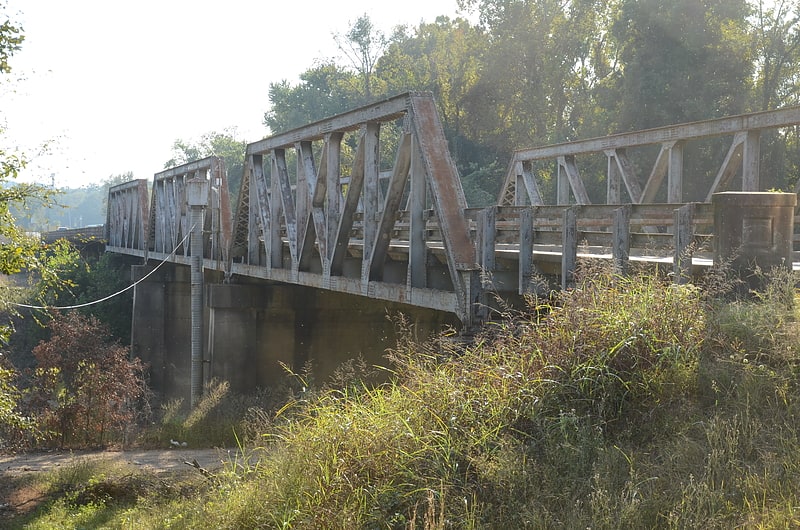
Bridge in Ouachita County, Arkansas. The Ben Laney Bridge is a historic bridge carrying U.S. Route 79 Business over the Ouachita River in Camden, Arkansas. The steel Pratt truss bridge was built in 1945–47, and dedicated to Acting Governor Benjamin Travis Laney. Its construction was delayed due to a shortage of steel. The bridge consists of three trusses with a total span of 129 feet, resting on reinforced concrete piers and abutments. The bridge also includes a 548-foot approach of I-beam decking, which was built in 1934.
The bridge was listed on the National Register of Historic Places in 2000.[6]
Ouachita County Courthouse
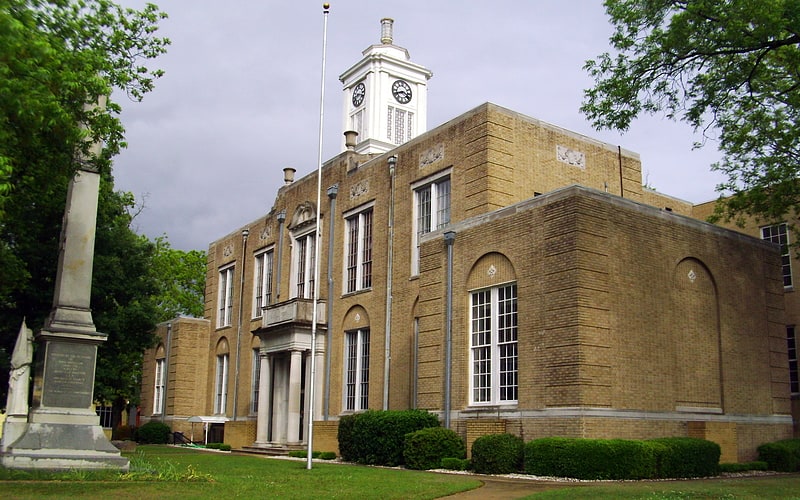
Building in Camden, Arkansas. The Ouachita County Courthouse is located at 145 Jefferson Avenue in Camden, Arkansas, the seat of Ouachita County. The two-story brick and concrete structure was designed by Little Rock architect Thomas Harding, and completed in 1933. The architecturally distinctive building exhibits a restrained Colonial Revival style (which was then passing out of fashion, with elements of Art Deco. It is a T-shaped building with symmetrical wings flanking a Classical style columned and gabled portico.
The building was listed on the National Register of Historic Places in 1989.[7]
Graham-Gaughan-Betts House
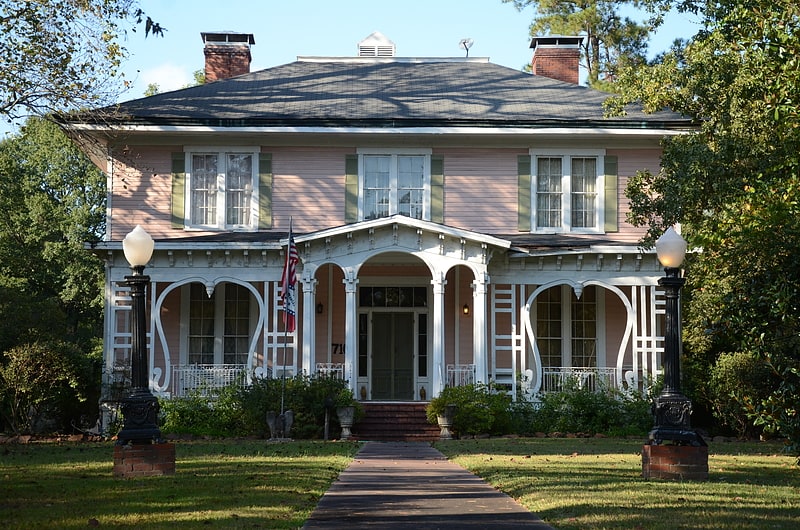
The Graham-Gaughan-Betts House is a historic house at 710 Washington Street in Camden, Arkansas. The two story wood-frame house was built in 1858 by Major Joseph Graham. It is particularly notable for its well-preserved interior woodwork, and its elaborately decorated front porch.
The house was listed on the National Register of Historic Places in 1974.[8]
Old Camden Post Office
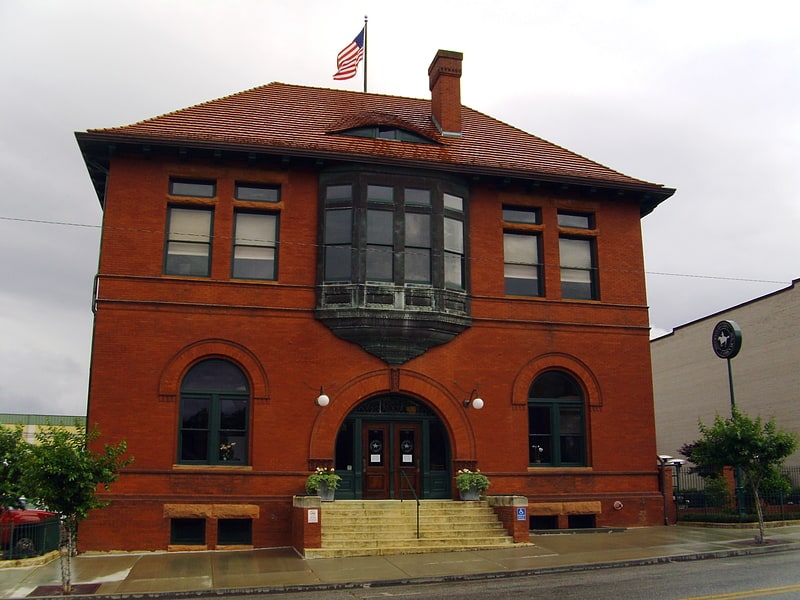
Post office in Camden, Arkansas. The Old Camden Post Office is a former post office building at 133 Washington Street SW in Camden, Arkansas. The two story Romanesque Revival structure was built in 1895, and is one of the city's finest brick buildings. It was described, shortly after its construction, as the "finest building between Little Rock and Texarkana". It originally housed the post office on the ground floor and the Federal Land Office on the second floor.
The building was listed on the National Register of Historic Places in 1977.[9]
Fort Lookout
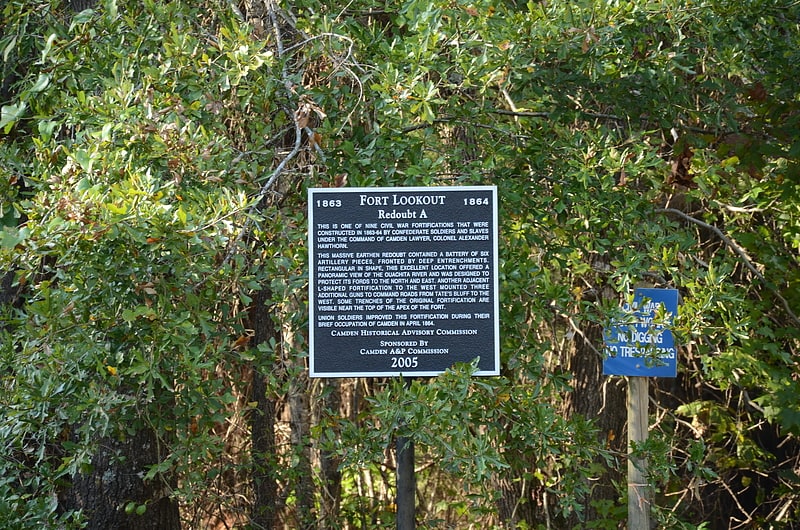
Historical place in Camden, Arkansas. Fort Lookout, also known as Redoubt A, is a defensive earthworks erected during the American Civil War on the outskirts of Camden, Arkansas. It was the northernmost of a series of five redoubts built in defense of the city by Confederate Army forces in early 1864, preparatory to the Union Army's Camden Expedition. The site has been designated a National Historic Landmark as part of the Camden Expedition Sites, a collection of military sites related to the expedition.[10]
Sidney A. Umsted House
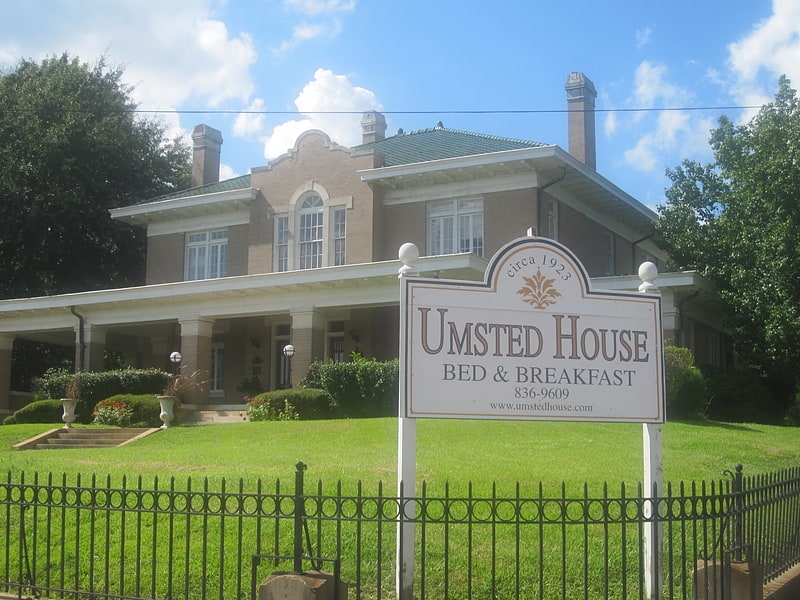
The Sidney A. Umsted House is a historic house at 404 Washington Street in Camden, Arkansas. The two story brick house was built in 1923–24, and is one of the best local examples of Mediterranean Revival architecture in the city. Sidney Umsted, for whom the house was built, became instantly wealthy with the discovery in 1922 of oil in nearby Smackover, and became one of Arkansas' wealthiest men. The house is faced in beige brick, and features a green tile roof.
The house was listed on the National Register of Historic Places in 1995. It is now a bed and breakfast inn.[11]